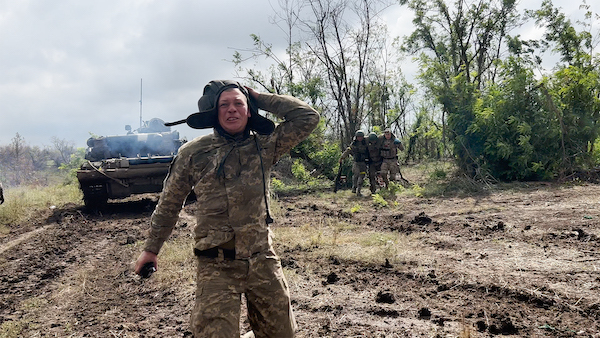Doc Talk: Maine Attractions
By Peter Keough
The vicious, virtual, voyeuristic, and vicarious are on view at this year’s Camden International Film Festival.
The Camden International Film Festival (September 14-17 and online September 18-25) is one of New England’s — and North America’s — most important annual documentary events. The fest never disappoints in its mission to present films that exemplify the cutting edge in formal innovation while tackling the most urgent political issues and cultural developments.
This year one recurrent theme involves the growing divide between the real and the virtual, between the detachment and disinformation of social media and the crushing immediacy of such real-life dangers as environmental collapse and encroaching totalitarianism.

A scene from Manifesto. Photo: Camden International Film Festival
Those are some of the specters haunting Manifesto (2022; screens September 15 at 9:30 p.m. at the Strand Theatre and available online September 18-25) from the apparently pseudonymous (for good reason) Russian filmmaker (or filmmaking collective?) Angie Vinchito.
A collage drawn from YouTube videos posted by Russian schoolchildren and teenagers, the documentary begins innocently enough (except for an alarmingly disingenuous disclaimer stating that the goal of the film “is not to encourage opposition”) with kids waking up and preparing for class. “Good morning, country,” says one sleepy-eyed girl. “Today we’re on duty,” says another girl cryptically as she heads out. “I don’t like it, but never mind.” “Nothing is beautiful,” says a boy trudging through the snow. “Everything is ugly.”
Then a siren goes off. “This is my last video,” a child’s voice announces stoically. Is it a drill, or a real nuclear war or terrorist attack?
Either way, for these children the everyday terror is systemic and routine. A teacher in a biology class casually slices a boy’s arm for a blood sample. It gushes and he faints. Another teacher, caught using a cell phone, molests a student. A teacher beats a kid in a hallway. Uniformed students chant patriotic phrases.
Some resist. Someone writes “Putin is a thief” on the blackboard. Another tosses the President’s picture into a trash barrel. Others are bolder, joining the nationwide pro-Alexei Navalny demonstrations in January 2021. When arrested, a few remain defiant. Others, shamefaced, grovel before police cameras as they confess their wrongdoing and promise never to repeat it.
Then there is the option of violent revolt. Some take up arms, but perversely turn them on their fellow students. The film features a montage of these school massacres, the panic, horror, and despair all too familiar to American viewers. It concludes with videos taken by a 15-year-old couple, runaways who barricaded themselves in a house with a shotgun and pellet rifle. They shoot up a police car and then, eventually, shoot themselves. Reminiscent of Dmitrii Kalashnikov’s The Road Movie (2018), another brutal, revelatory, found-footage compilation, Manifesto is a call for justice, decency, and accountability.

A scene from A Hawk as Big as a Horse. Photo: Camden International Film Festival
The teenagers in Manifesto opted for a Badlands–style escape from oppression and ennui. The mysterious subject of Sasha Kulak’s A Hawk as Big as a Horse (2022; screens September 15 at 10 a.m. at the Journey’s End, available online September 18-25) favors a brand of escapism that resonates with the solipsistic absurdity of David Lynch’s Twin Peaks.
Lydia, born Sergei, is a 48-year-old Russian ornithologist who was fired from her role at the Moscow Agricultural University. Now she lives with her wife Vasilisa, a trainer of police horses, in an isolated compound deep in the woods of Shcherbinka, a town outside of Moscow. There she traps birds, explores the forest where she claims to discover dead bodies, and engages in play-acting that is part scientific, part mythic, part bizarro fairy tale, all of it bewildering. What, for example, do we make of the “nezhulia,” imaginary creatures whose mating ritual is enacted by two women rubbing elbows? Compared to this and other oddities, Lydia’s meticulous recreation of the dream sequence from Lynch’s uncanny TV series — complete with red curtains, zig-zag carpet, nude statue, and the dancing Man from Another Place — is pretty straightforward.
The filmmaker agrees to help Lydia with her Twin Peaks reenactment if she will cooperate in a documentary about herself. But somewhere along the way Kulak and Lydia’s projects began to merge and the result is a surreal reverie with only glancing connections to the real world. The images are often numinous and stunning, especially the simplest, such as a sequence in which Lydia leads a herd of ghostly white goats into the forest at dusk. But the studied obscurity and weirdness sometimes dwindle into inanity. “What you are asking for is completely useless,” Lydia snaps at one point. “This is like a pseudo-documentary. This is nonsense.”
In the end, Lydia works on another project, the Frankenstein-like recreation of the star of Twin Peaks, Lara Flynn Boyle, from the skeleton outward. The results are creepily convincing. The experiment is a success — a nude, anatomically exact replica, forever young, a Sleeping Beauty in a glass coffin. “What is the point of creating her?” Kulak asks. “It’s Shakespearean,” says Lydia, and quotes from Sonnet LXV. “‘Shall Time’s best jewel from Time’s chest lie hid?’”

A scene from Knit’s Island. Photo: Camden International Film Festival
Unlike Kulak, Guilhem Causse, Ekiem Barbier and Quentin L’helgoualc’h, the filmmakers of Knit’s Island (2023; screens September 16 at 5 p.m. at the Strand Theatre), remain detached and objective in their observations, even as they immerse themselves in their subjects’ fantasy world. Or do they?
They set out to document the survivalist video game DayZ, hoping to demonstrate that — rather than intensifying antisocial tendencies and anomie — such role-playing scenarios can instead develop interpersonal bonds and a sense of community.
Set on a Russian island (it looks like post-meltdown Chernobyl) after a generic worldwide plague has wiped out most of the human race except for a handful of survivors and roaming bands of murderous zombies, the game calls for players to develop survivor skills as well as form groups for mutual protection. Wearing “Press” labelled flak jackets, the filmmakers enter the game (which they end up playing for over 900 hours) and set out to interview some of these groups to learn about their communities’ ethos and perhaps something about their lives in the nonvirtual world.
The first bunch, “The Midnight Crew,” is disappointing. Heavily armed, masked, and moronic, they are led by a blithely homicidal young woman in a Soviet officer’s cap, a plaid miniskirt, and carrying two assault rifles. They interview her in a battered room surrounded by her armed minions. “Basically we do whatever we want when we want. We value strength. Chaos. Destruction,” she says. A middle aged man in shorty pajamas smoking a cigarette lies on a desk, impassive. As the discussion proceeds it gradually dawns on the crew that the man on the desk might be the crew’s dinner. These players are like the nihilist children in Manifesto, except more sadistic, devoid of pathos, with better weapons, and facing no consequences for their actions.
At first the next group also seems unpromising. We meet them in the gem-like ruin of an Orthodox church where they worship the Lord Dagoth. The outfit is led by Reverend Stone, a Slavic-accented figure with a taste for country music who wears a cowboy hat and carries a teddy bear. His followers are heavily armed and intimidatingly costumed but eventually prove laidback, friendly, and open to self-reflection. The faux church is just another gimmick of gameplay: the filmmakers are able to talk to them, and other similarly civilized groups, that they encounter after this about personal subjects. Members talk about their lives outside the game, their real-life surroundings, whether sitting late at night in an apartment somewhere in front of a computer screen, or in a basement alone until interrupted by a child needing attention upstairs.
Near the end the filmmakers join Reverend Stone by the seashore. He looks like Col. Kilgore in Apocalypse Now. “I only wanted to play a game,” he confesses, “but I realized I can’t escape my life.” He walks to the water, and then walks on the water, singing Waylon Jennings’s “You Ask Me To” until he vanishes over the horizon.

A scene from Eastern Front. Photo: Camden International Film Festival
In Vitaly Mansky and Yevhen Titarenko’s Eastern Front (2023; screens September 16 at 2 p.m. at the Strand Theatre, and available online September 18-25) a volunteer medical unit called The Hospitallers (Titarenko himself serves as a medic in the group) travels through ruined vistas similar to those in Knit’s Island. Many scenes are shot with handheld cameras or body-mounted GoPros, which add to the resemblance. But the moans and screams of the wounded and the first glimpse of a dismembered body disabuse one of any illusions this might be a video game.
In a recurring scene, the medics, on leave, have gathered for a family picnic where they chat and reminisce by the side of a placid lake as kids and dogs gambol about them. They talk about freezing their sperm to guarantee they will have progeny if they are killed, about how pro-Russian relatives still don’t comprehend the truth, and about the war. Then a cut will be made to some scene of warfare: someone cooking a meal in the kitchen of an abandoned house as we hear artillery blasts striking buildings across the river; a soldier wishing everyone “Happy Mother’s Day!” while standing next to the turret of a blown up Russian tank; medics driving pell-mell to a battlefield, Ennio Morricone’s “The Ecstasy of Gold” booming from the radio, then rushing out of the vehicle amidst crackling gunfire to pile groaning wounded into the back of the van.
As excruciating as is the human suffering, the agony of animals is particularly affecting, such as the resigned lowing of a herd of doomed cows sinking into a swamp at an abandoned farm, or the yelps of a dog whom a soldier shoots again and again to put it out of its misery. Perhaps the most harrowing sequence in the film is the first, in which the medics rush in a ragtag ambulance from the front line to a hospital trying to keep alive a wounded soldier bleeding out. Will he survive? As with the outcome of the war itself, we are left in doubt.
Peter Keough writes about film and other topics and has contributed to numerous publications. He had been the film editor of the Boston Phoenix from 1989 to its demise in 2013 and has edited three books on film, most recently For Kids of All Ages: The National Society of Film Critics on Children’s Movies (Rowman & Littlefield, 2019).
